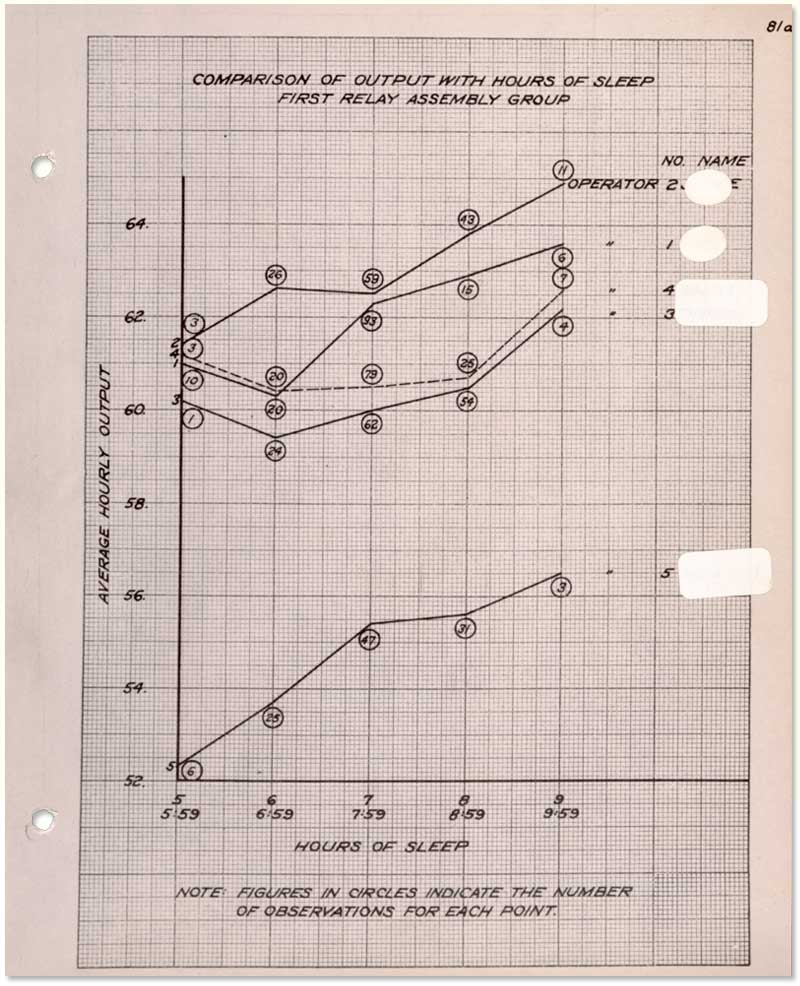霍桑实验(Hawthorne experiments)是管理学史上著名实验,是泰勒制管理思维转向行为主义、人本主义等多元化管理思维的重要开端。上世纪初,美国工业空前迅猛发展,受科学管理学派的影响和指导,标准化、规范化、流水线等先进管理手段大规模运用到生产中,极大地提高了生产效率。然而,伴随的问题也接踵而至,罢工、员工频繁流动等社会问题也困扰着产业发展。当时在芝加哥的众多纺织厂里,员工们的离职率、流动率很高,这些离职的员工并没有离开纺织业,只是换了一家工厂,而这些纺织厂的条件和待遇都相差不大。类似的情况在各行各业大量涌现。
1924年,美国国家研究委员会(National Research Council)和洛克菲勒基金会(Rockefeller Foundation)支持下,在大型工业企业西部电气霍桑工厂进行系列管理实验,试图找出能提高生产效率的工作条件因素。然而,实验进行了三年,至1927年,仍未取得实质性进展。于是,研究队伍邀请了哈佛大学商学院(Harvard Business School)教授埃尔顿•梅奥(Elton Mayo)及其门徒弗里茨•j•罗特里斯伯格(Fritz J. Roethlisberger)加入。随后的实验延续到了1932年,在此实验期间,多种举措使得生产效率得到了提高。
梅奥是人际关系学派创始人,从新的视角指出了管理思路,而霍桑实验反映了管理中“人与社会关系”的因素重要性,也从另一个方面反映了单一采用科学管理学派管理思维的局限性。

哈佛大学商学院关于人际关系学派及霍桑实验的介绍
In the 1920s Elton Mayo, a professor of Industrial Management at Harvard Business School, and his protégé Fritz J. Roethlisberger led a landmark study of worker behavior at Western Electric, the manufacturing arm of AT&T. Unprecedented in scale and scope, the nine-year study took place at the massive Hawthorne Works plant outside of Chicago and generated a mountain of documents, from hourly performance charts to interviews with thousands of employees. Harvard Business School’s role in the experiments represented a milestone in the dawn of the human relations movement and a shift in the study of management from a scientific to a multi-disciplinary approach. Baker Library’s exhaustive archival record of the experiments reveals the art and science of this seminal behavioral study—and the questions and theories it generated about the relationship of productivity to the needs and motivations of the industrial worker.

当时霍桑工厂鸟瞰图(图片源自哈佛大学图书馆资料网站)
From the time of its founding in 1876, AT&T’s rapid and pervasive expansion gave it a virtual monopoly over the telephone industry until the time of its break-up in 1984. Like other conglomerates of its day, the Bell Telephone System, as the entire enterprise was known, combined production, distribution, and marketing under one corporation as a way to centralize its operations and eliminate competition. Western Electric, the manufacturing unit of the company, produced telephones, cables, transmission equipment, and switching equipment.
Construction of the Western Electric Hawthorne Works on over 100 acres in Cicero, Illinois, began in 1905. By 1929 more than 40,000 men and women reported to work at the massive plant, which included offices, factories, a hospital, fire brigade, laundry facilities, and a greenhouse. Employees were assigned to precisely measured tasks in highly specialized departments, from switchboard wiring to punch-and-die tool making. The manufacture of some equipment, such as automatic telephone exchanges, required hundreds of separate assembly and inspection operations, and Western Electric became one of the forerunners in applying scientific management (inspired in part by Frederick Taylor’s time and motion studies) to its production units.
1905年,在伊利诺斯州西塞罗占地100多英亩的西部电力公司霍桑工厂开工建设。到1929年,据报道有超过4万名男性和女性在这个巨大的工厂工作,包括办公室、工厂、医院、消防队、洗衣设施和温室。员工被分配到高度专业化的部门,从事精确测量的工作,从配线到冲模工具制造。一些设备的制造,如自动电话交换机,需要数百个独立的装配和检查操作,西部电力公司成为将泰勒科学管理应用于其生产的先驱之一。

In the early 1900s labor unions, social reformers, journalists, and photographers brought to national attention poor working conditions experienced by industrial workers. In the ensuing economic climate of the late 1920s and 1930s, many executives came to believe that the foundation of business and of a democratic society itself rested in part in affirming the role of the worker. To inspire company loyalty, discourage high employee turnover and unionization, and present a good face to the public, corporate managers began to focus on the well-being of the employee through the practice of welfare capitalism.
In addition to pensions, sick pay, disability benefits, and stock purchase plans, Western Electric workers could participate in a range of recreational and educational programs from running meets, tennis games, and baseball leagues to lunchtime concerts, beauty pageants, and evening classes. The company’s accident prevention programs included the introduction of safety shoes, eye goggles, and guards for heavy machinery. To better understand worker productivity and job satisfaction, Western Electric became increasingly interested in studies from the social, behavioral, and medical sciences.
霍桑实验大致可分为四个阶段:
一. 1924-1927年工厂照明实验:Illumination Studies——硬件条件实验。
照明实验中,在三个独立制造部门,研究人员将分别参加实验的工人分为两组:控制组和实验组,控制组在正常照明强度下工作,对实验组先进行照明强度逐渐增加,再进行逐渐降低。实验结果表明,生产效率和照明强度之间没有显著的相关性。

Illumination Study, 1926
二. 1927-1929年继电器装配实验:Relay Assembly Test Room——福利实验。
继电器装配实验是指在继电器装配部门进行的实验,研究人员让参加实验的女工在一个单独实验室工作,先后进行增加休息时间,缩短的工作时间,增加工资的激励,增加茶点供应,然后再逐渐取消这些待遇,结果发现无论工作待遇如何变化,生产效率依然得到大幅增加。

Women in the Relay Assembly Test Room, ca. 1930 Western Electric Company Hawthorne Studies Collection
研究人员不确定生产效率的提高,是因为工作条件改善还是因为女工得到了特殊的关注。1928年,西电公司的主管乔治·佩诺克(George Pennock)向哈佛商学院的埃尔顿·梅奥(Elton Mayo)寻求指导,梅奥及其助手正式加入研究。

Comparison of Output with Hours of Sleep First Relay Assembly Test Group, ca. 1930 Western Electric Company Hawthorne Studies Collection
在随后的研究中,先后进行了取消生产监督,进行集体奖励和个人奖励等多种实验,生产效率均得到了大幅提高。经过工人的反馈和对数据的分析,Mayo指出:团队中的精神态度、适当的监督和非正式的社会关系是提高生产力和工作满意度的关键。(mental attitudes, proper supervision, and informal social relationships experienced in a group were key to productivity and job satisfaction)
三. 1928-1930年大规模访谈实验:Interview Studies——访谈或关注实验。
在梅奥和其助手罗特里斯伯格的指导下,工厂举行了超过21,000个访谈。他们鼓励工人自由表达意见和建议,提出批评和不满,后期将访谈内容扩展至家庭、同事关系、个人理想等诸多方面。通过访谈,工厂生产效率得到大幅提高。梅奥发现,民主宽松氛围、集体荣誉和良好同事关系、个人价值观和目标、被重视感等以往被忽略的因素,对生产效率产生重大影响。

四. 1931-1932年接线板接线工作室实验——群体实验。
通过对14名男工的生产小组进行观察实验,这个小组根据集体产量计算工资,按该组的人员配置,常理下产量应该完全能超过原有实际产量。然而,经过几个月的统计,小组产品总是维持在一定水平上下。研究人员发现,组内存在某种自动限产的默契,谁都不会冒尖超产。研究人员把这种默契称为非正式组织,非正式组织内存在非明文的约束,这种约束力甚至超过了经济上的刺激。
霍桑实验在1933年经济大萧条来临时伴随西部电气大规模裁员戛然而止。
梅奥等人通过实验总结,得出核心结论:生产效率的不仅仅受到物理、生理因素的影响,还受到社会环境、社会心理的影响。主要体现在以下几个方面:
1.员工是“社会人”而不仅仅是“经济人”。实验表明,物质条件的刺激不是提高生产效率的决定性因素,甚至于计件制的刺激对产量的影响也不及集体所形成的一种自然力量大。人不是孤立的,而是存在于一个集体中并受到集体的影响,不是单纯追求金钱收入,还追求人与人之间的友情、安全感、归属感、成就感等社会和心理的满足。
2.员工的士气(积极性、团队精神、安全感归属感等等综合心理因素)对提高生产效率有重要影响。作业方法、工作条件、刺激制度等管理科学学派注重的因素并不是关键因素,而工作态度的改变即员工士气的提高,才是决定性因素。
3.企业中存在非正式组织。员工群体中有着以感情为基础不成文的准则和惯例,这是一种人群关系的综合体现,对企业生产效率有重要影响。
4.企业应采用新型的领导方式,充分提高员工的参与热情、积极主动性,尊重员工的意见,重视员工的不满表达,消除不良的人际因素。
以霍桑实验为基础的人际关系管理理论,通过梅奥提出并迅速受到管理学界的重视,是唯尊科学管理学派的转折。
>>